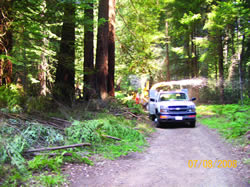
National Fire Plan Success Story
Bolinas Ridge Fuelbreak Uses Best Management Practices
Point Reyes National Seashore, California
National Fire Plan - Fuels Reduction
2009

Fuels crew at work on the Bolinas Ridge fuelbreak.
During the 2009 field season, the hazardous fuels crew for the San Francisco Bay Area National Parks completed the second phase of work on a 5-mile fuelbreak along the Bolinas Ridge fire road. This fire road marks the border between National Park Service and Marin Municipal Water District lands in the western part of Marin County, California. A fire moving east across this fire road could threaten thousands of homes in the San Geronimo Valley and the town of Fairfax, as well as a critical drinking water supply which serves the majority of the county. A fire moving west across the fire road could threaten thousands of homes in Olema, Bolinas and Stinson Beach. The goal of this project was to improve the fire road for emergency access and for use as a fire control line if necessary. The fuel treatment extends from the Randall Trail intersection south to Bolinas-Fairfax Road, 60-80 feet from the edge of the fire road in a mixture of Douglas fir / redwood forest and maritime chaparral. Small trees, 8 inches in diameter or less are being removed, while larger trees are being limbed up to a height of 10 feet. Most shrubs and all large, down woody fuels are being removed within the first 15 feet of the road. Farther out, shrubs are being spaced at a distance of one and a half times their height. Fuel loads in this area have increased in recent years due to the die off of trees associated with Sudden Oak Death.
An important consideration in planning this fuelbreak was the existence of three rare plants in the project area, which include one manzanita and two ceanothus species. These plants are fire stimulated obligate seeders whose populations are very small, and are thought to be declining in the absence of fire. Furthermore, Northern spotted owls, a federally threatened species also nests in the project area. Mitigations to avoid impacts to these species were crucial to the success of the project. Prior to finalizing the prescription for treatment, the National Park Service contracted with biologists to survey populations of the rare Marin manzanita and develop recommendations for management. These efforts included forming an advisory group to ensure the final report establishing best management practices would undergo rigorous peer review. All of the rare plants in the project area are being flagged and are being left intact by the fuels crew, who also receives training in how to recognize these plants. Meanwhile, bird nesting surveys are completed each year before work begins under a cooperative agreement with PRBO Conservation Science, a nationally recognized bird conservation organization.
The thinning treatment on Bolinas Ridge may in fact benefit the rare plants by opening up areas to more sunlight and increasing seed production. In the meantime, fuel has been substantially reduced on approximately 30 acres of the 60-acre project so far. Comments by the public who use the trail for recreation indicate they are enthused by the obvious reduction in fire hazard, and collaboration with the Marin Municipal Water District about fuels management along the fire road has increased as a result of the work accomplished to date.
Contact: Jennifer Chapman, Fire Communication and Education Specialist, (415) 464-5133.